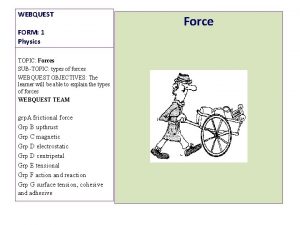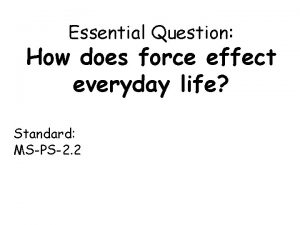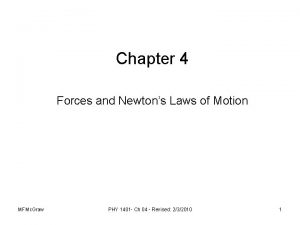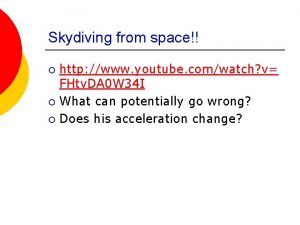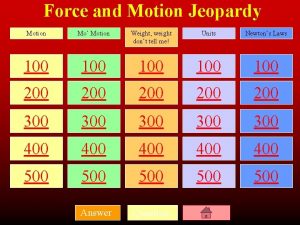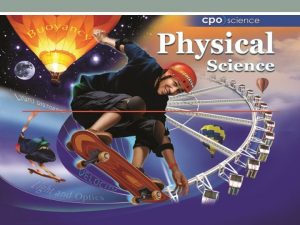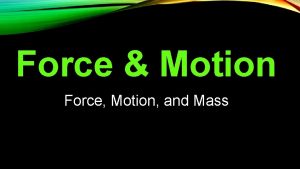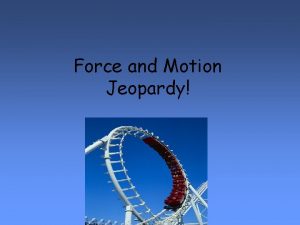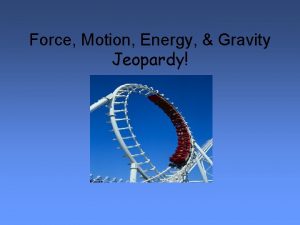Motion and Force What is a Force Force














- Slides: 14

Motion and Force

What is a Force? • Force- any action that can change the state of motion of an object • Four fundamental forces in nature – Gravity – Electromagnetic force – Strong nuclear force – Weak nuclear force • F=mxa – Force equals mass times acceleration

Fundamental Forces • Vary in strength • How do forces act? – Contact forces- push/pull – Field forces- do not require objects to touch each other (ex: gravity) • Both types of forces can cause an object to move or stop moving

Balanced vs. Unbalanced Forces • Net force- combination of all forces acting on an object – Object accelerates in the direction of the net force (unbalanced) – Object will not accelerate if the net force is zero (balanced)

Newton’s First Law • An object at rest remains at rest and an object in motion stays in motion unless it experiences a net force. • Inertia: the tendency of an object to resist change in motion – Related to the mass of an object – Objects with greater mass have a greater inertia (Is it harder to move a baseball or a car? ) • Newton’s First Law is also called the Law of Inertia

Newton’s Second Law • The unbalanced force acting on an object equals the object’s mass times its acceleration. • Force is measured in Newtons (N) – 1 N = 0. 225 pounds

How do We Calculate Net Force? • If forces are in the same direction, you add them. What is the net force acting on this box? • If forces are in opposite directions, you subtract. What is the net force?

Calculating Acceleration •

Multi-Step Problems 1. A 2000 kg car moving at 10 m/s accelerates to 15 m/s in 3 seconds. What is the force applied to the car? 2. A 2 kg ball is thrown from rest to a speed of 60 m/s. How much time is needed if the net force applied is 300 N? 3. A force of 45 N is applied to a 15 kg cart for 6 seconds. If it starts from rest, what will be its final velocity?

Practice Problems 1. A 1300 kg car moving at 25 m/s accelerates to 40 m/s in 3 seconds. What is the force applied to the car? 2. A 1. 4 kg ball is thrown from rest to a speed of 85 m/s. How much time is needed if the net force applied is 500 N? 3. A force of 300 N is applied to a 40 kg cart for 1. 5 seconds. If it starts at 20 m/s, what will be its final velocity?

Friction • Friction- force that opposes motion – Produces heat • Static friction is between stationary surfaces • Kinetic friction is between moving surfaces

Newton’s Third Law • For every action force, there is an equal and opposite reaction force. • Forces always occur in pairs!

Momentum • Defined as the product of an object’s mass and velocity p = mv • Momentum increases as mass and velocity increase.

Calculating Momentum • Calculate the momentum of a 6. 0 kg bowling ball moving at 10. 0 m/s down the alley toward the pins. p = mv p = (6. 0 kg)(10. 0 m/s) = 60. 0 kg m/s
 Range of motion types
Range of motion types What is the formula of simple harmonic motion
What is the formula of simple harmonic motion An object in motion stays in motion
An object in motion stays in motion Chapter 2 motion section 1 describing motion answer key
Chapter 2 motion section 1 describing motion answer key Measuring motion
Measuring motion Chapter 2 motion section 1 describing motion answer key
Chapter 2 motion section 1 describing motion answer key Chapter 11 section 1 measuring motion answer key
Chapter 11 section 1 measuring motion answer key Motion section 1 describing motion
Motion section 1 describing motion Force and motion webquest
Force and motion webquest Section 3 motion and forces worksheet answers
Section 3 motion and forces worksheet answers Aristotle and galileo views of motion
Aristotle and galileo views of motion Is invisible force than can produce heat, light and motion
Is invisible force than can produce heat, light and motion Study jams forces and motion
Study jams forces and motion Forces and motion summary
Forces and motion summary Bill nye force and motion youtube
Bill nye force and motion youtube








